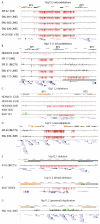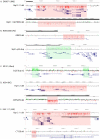Genome-wide copy number variation in epilepsy: novel susceptibility loci in idiopathic generalized and focal epilepsies
- PMID: 20502679
- PMCID: PMC2873910
- DOI: 10.1371/journal.pgen.1000962
Genome-wide copy number variation in epilepsy: novel susceptibility loci in idiopathic generalized and focal epilepsies
Abstract
Epilepsy is one of the most common neurological disorders in humans with a prevalence of 1% and a lifetime incidence of 3%. Several genes have been identified in rare autosomal dominant and severe sporadic forms of epilepsy, but the genetic cause is unknown in the vast majority of cases. Copy number variants (CNVs) are known to play an important role in the genetic etiology of many neurodevelopmental disorders, including intellectual disability (ID), autism, and schizophrenia. Genome-wide studies of copy number variation in epilepsy have not been performed. We have applied whole-genome oligonucleotide array comparative genomic hybridization to a cohort of 517 individuals with various idiopathic, non-lesional epilepsies. We detected one or more rare genic CNVs in 8.9% of affected individuals that are not present in 2,493 controls; five individuals had two rare CNVs. We identified CNVs in genes previously implicated in other neurodevelopmental disorders, including two deletions in AUTS2 and one deletion in CNTNAP2. Therefore, our findings indicate that rare CNVs are likely to contribute to a broad range of generalized and focal epilepsies. In addition, we find that 2.9% of patients carry deletions at 15q11.2, 15q13.3, or 16p13.11, genomic hotspots previously associated with ID, autism, or schizophrenia. In summary, our findings suggest common etiological factors for seemingly diverse diseases such as ID, autism, schizophrenia, and epilepsy.
Conflict of interest statement
The authors have declared that no competing interests exist.
Figures


References
-
- Hauser WA, Annegers JF, Rocca WA. Descriptive epidemiology of epilepsy: contributions of population-based studies from Rochester, Minnesota. Mayo Clin Proc. 1996;71:576–586. - PubMed
-
- Koolen DA, Vissers LE, Pfundt R, de Leeuw N, Knight SJ, et al. A new chromosome 17q21.31 microdeletion syndrome associated with a common inversion polymorphism. Nat Genet. 2006;38:999–1001. - PubMed
-
- Sagoo G, Butterworth A, Sanderson S, Shaw-Smith C, Higgins J, et al. Array CGH in patients with learning disability (mental retardation) and congenital anomalies: updated systematic review and meta-analysis of 19 studies and 13,926 subjects. Genet Med. 2009;11:139–146. - PubMed
Publication types
MeSH terms
Grants and funding
LinkOut - more resources
Full Text Sources
Other Literature Sources
Medical
Research Materials

